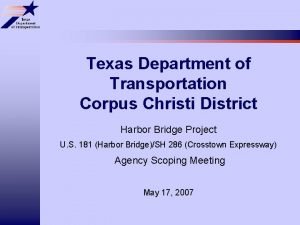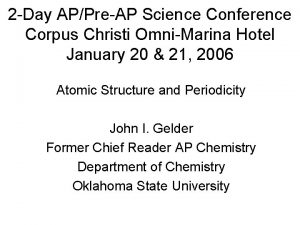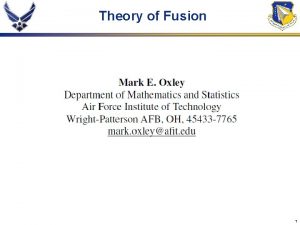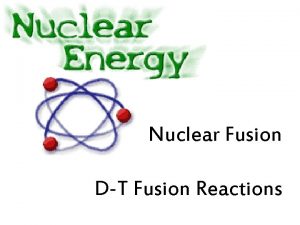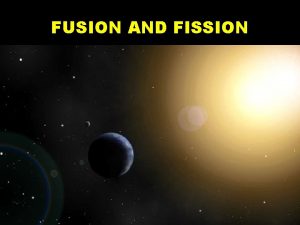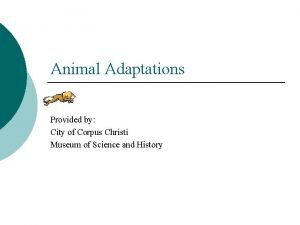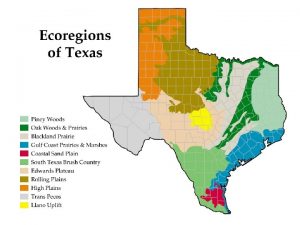2003 International Sherwood Fusion Theory Conference Corpus Christi























- Slides: 23

2003 International Sherwood Fusion Theory Conference Corpus Christi, TX, April 2003 Stability Properties of Field-Reversed Configurations (FRC) E. V. Belova PPPL

OUTLINE: I. Linear stability (n=1 tilt mode, prolate FRCs) - FLR stabilization - Hall term versus FLR effects - resonant particle effects - is linearly-stable FRC possible? “usual” (racetrack) FRCs vs long, elliptic-separatrix FRCs II. Nonlinear effects - nonlinear saturation of n=1 tilt mode for small S* - nonlinear evolution for large S*

Ψ R R φ Z FRC parameters:

Numerical Studies of FRC stability code – HYM (Hybrid & MHD): • • 3 -D nonlinear Three different physical models: - Resistive MHD & Hall-MHD -large S* - Hybrid (fluid e, particle ions) -small S* - MHD/particle (fluid thermal plasma, energetic particle ions) For particles: delta-f /full-f scheme; analytic Grad-Shafranov equilibria

I. Linear stability - Concentrate on n=1 tilt mode (most difficult to stabilize, at least theoretically) - Three kinetic effects to consider: 1. FLR stabilizing 2. Hall destabilizing, and obscure the first two 3. Resonant particle effects Long FRC equilibria: “Usual” equilibria Elliptical equilibria analytic p(ψ) & racetrack-like special p(ψ) [Barnes, 2001] • end-localized mode • γ saturates with E • always global mode • γ scales as 1/E • more stochastic

I. Linear stability: Hall effect To isolate Hall effects Hall-MHD simulations of the n=1 tilt mode Hall-MHD simulations (elliptic separatrix, E=6) - Compare with analytic results: Stability at S*/E 1 [Barnes, 2002] 1/S* Growth rate is reduced by a factor of two for S*/E 1. Hall stabilization: not sufficient to explain stability; FLR and other kinetic effects must be included.

I. Linear stability: Hall effect In Hall-MHD simulations tilt mode is more localized compared to MHD; also has a complicated axial structure. MHD Hall effects: Hall-MHD • modest reduction in (50% at most) • rotation (in the electron direction ) • significant change in mode structure Change in linear mode structure from MHD and Hall-MHD simulations with S*=5, E=6.

I. Linear stability: FLR effect - cannot isolate FLR effects without making FLR expansion hybrid simulations with full ion dynamics, but turn off Hall term Hybrid simulations with and without Hall term; E=4 elliptic separatrix. Without Hall With Hall Growth rate reduction is mostly due to FLR; however, Hall effects determine linear mode structure and rotation.

I. Linear stability: FLR vs Hall Hybrid simulation without Hall term R Hybrid simulation with Hall term R Z FLR: Mode is MHD-like, Z FLR & Hall: Mode is Hall-MHD-like,

I. Linear stability: Elongation and profile effects E=4 E=6 Elliptical equilibria (special p( ) profile) E=12 - For S*/E>2 growth rate is function of S*/E. - For S*/E<2 growth rate depends on both E and S* , and resonant particles effects are important. Racetrack equilibria (various p( ) profiles) - S*/E-scaling does not apply. Hybrid simulations for equilibria with elliptical separatrix and different elongations: E=4, 6, 12. For S*/E<2, resonant ion effects are important. S*/E scaling agrees with the experimental stability scaling [M. Tuszewski, 1998].

I. Linear stability: Resonant effects Betatron resonance condition: Ω – ω = ω β [Finn’ 79]. Growth rate depends on: 1. number of resonant particles 2. slope of distribution function 3. stochasticity of particle orbits

I. Linear stability: Resonant effects MHD-like Particle distribution in phase-space for different S* (E=6 elliptic separatrix) Lines correspond to resonances: Kinetic As configuration size reduces, characteristic equilibrium frequencies grow, and particles spread out along axis – number of particles at resonance increases. Stochasticity of ion orbits – expected to reduce growth rate.

Stochasticity of ion orbits For majority of ions µ is not conserved in typical FRC: For elongated FRCs with E>>1, Two basic types of ion orbits (E>>1): Betatron orbit Drift orbit For drift orbit at the FRC ends stochasticity. Betatron orbit (regular) Drift orbit (stochastic)

Regularity condition can be obtained considering particle motion in the 2 D effective potential: Shape of the effective potential depends on value of toroidal angular momentum Regularity condition: (Betatron orbit) (Betatron or drift, depending on ) Number of regular orbits ~ 1/S* Racetrack, E=7 regular Elliptic, E=6, 12 stochastic Regular versus stochastic portions of particle phase space for S*=20, E=6. Width of regular region ~ 1/S*. Fraction of regular orbits in three different equilibria.

I. Linear stability: Resonant effects In f simulations evolve not f , but simulation particles has weights , where , which satisfy: => It can be shown that growth rate can be calculated as: Here - plays role of perturbed particle energy. Simulations with small S* show that small fraction of resonant ions (<5%) contributes more than ½ into calculated growth rate – which proves the resonant nature of instability.

I. Linear stability: Resonant effects Hybrid simulations with different values of S*=10 -75 (E=6, elliptic) Scatter plots in plane; resonant particles have large weights. w Ω – ω = l ω β , l=1, 3, … For elliptical FRCs, FLR stabilization is function of S*/E ratio, whereas number of regular orbits, and the resonant drive scale as ~1/S* long configurations have advantage for stability. w -1 0 1 2 3 4 5 6 7 8 9 Larger elongation, E=12, case is similar, but resonant effects become important at larger S* smaller number of regular orbits, and smaller growth rates.

I. Linear stability Wave-particle resonances are shown to Scatter plot of resonant particles in phase-space. • occur only in the regular region of the phase-space; • highly localized. Possibilities for stabilization: • Non-Maxwellian distribution function. • Reduce number of regular-orbit ions. Investigated the effects of weak toroidal field on MHD stability - destabilizing (!) for B ~ 10 -30% of external field growth rate increases by ~40% for B =0. 2 B ext (S*=20).

I. Non-linear effects: Small S* Nonlinear evolution of tilt mode in kinetic FRC is different from MHD: - instabilities saturate nonlinearly when S* is small [Belova et al. , 2000]. Resonant nature of instability at low S* agrees with non-linear saturation, found earlier. Saturation mechanisms: - flattening of distribution function in resonant region; - configuration appear to evolve into one with elliptic separatrix and larger E. Hybrid simulations with E=4, s=2, elliptical separatrix.

II. Non-linear effects: Large S* Nonlinear hybrid simulations for large S* (MHD-like regime). • Linear growth rate is comparable to MHD, but nonlinear evolution is considerably slower. • Field reversal ( ) is still present after t=30 t A. 0 10 20 30 R Z (a) Energy plots for n=0 -4 modes, (b) Vector plots of poloidal magnetic field, at t=32 t A. Effects of particle loss: • About one-half of the particles are lost by t=30 t. A. • Particle loss from open field lines results in a faster linear growth due to the reduction in separatrix beta. • Ions spin up in toroidal (diamagnetic) direction with V 0. 3 v. A.

Future directions (FRC stability) • Low-S* FRC stability is best understood. • Can large-S* FRCs be stable, and how large is large? • Which effects are missing from present model: - The effects of non-Maxwellian ion distribution. - The effects of energetic beam ions. - Electron physics (e. g. , the traped electron curvature drifts). - Others?

Summary • Hall term – defines mode rotation and structure. • FLR effects – reduction in growth rate. • S*/E scaling has been demonstrated for elliptical FRCs with S*/E>2. • Resonant effects – shown to maintain instability at low S*. • Stochasticity of ion orbits is not strong enough to prevent instability; regularity condition has been derived; number of regular orbits has been shown to scale lnearly with 1/S*. • Nonlinear saturation at low S* – natural mechanism to evolve into linearly stable configuration. • Larger S* - nonlinear evolution is different from MHD: much slower; ion spin-up in diamagnetic direction.


 Tejas nacogdoches
Tejas nacogdoches Reed foster corpus christi
Reed foster corpus christi Texas department of transportation corpus christi
Texas department of transportation corpus christi Iv domingo de cuaresma ciclo b
Iv domingo de cuaresma ciclo b La eucaristia importancia
La eucaristia importancia Anima christi, sanctifica me
Anima christi, sanctifica me Corpus christi imagenes para niños
Corpus christi imagenes para niños O'que é corpus christi
O'que é corpus christi Corpus christi procession
Corpus christi procession Lecturas del dia de corpus christi
Lecturas del dia de corpus christi Corpus christi de la isleta
Corpus christi de la isleta Male reproductive system lateral view
Male reproductive system lateral view English
English Rob sherwood reviews
Rob sherwood reviews Sherwood parkdale
Sherwood parkdale Marking
Marking Rivers passing through sherwood forest
Rivers passing through sherwood forest Rob sherwood receiver test
Rob sherwood receiver test Cq bw contest
Cq bw contest Bestwood and sherwood midwifery
Bestwood and sherwood midwifery The egg sherwood anderson summary
The egg sherwood anderson summary Rob sherwood architect
Rob sherwood architect Sherwood parkdale skating club
Sherwood parkdale skating club Newark and sherwood homes bidding
Newark and sherwood homes bidding


